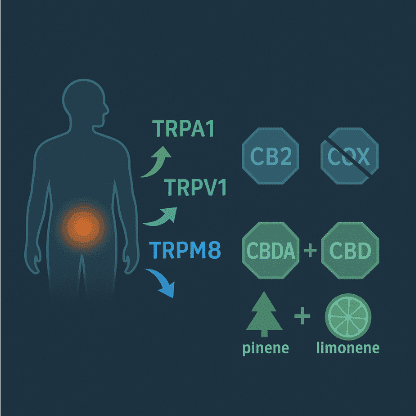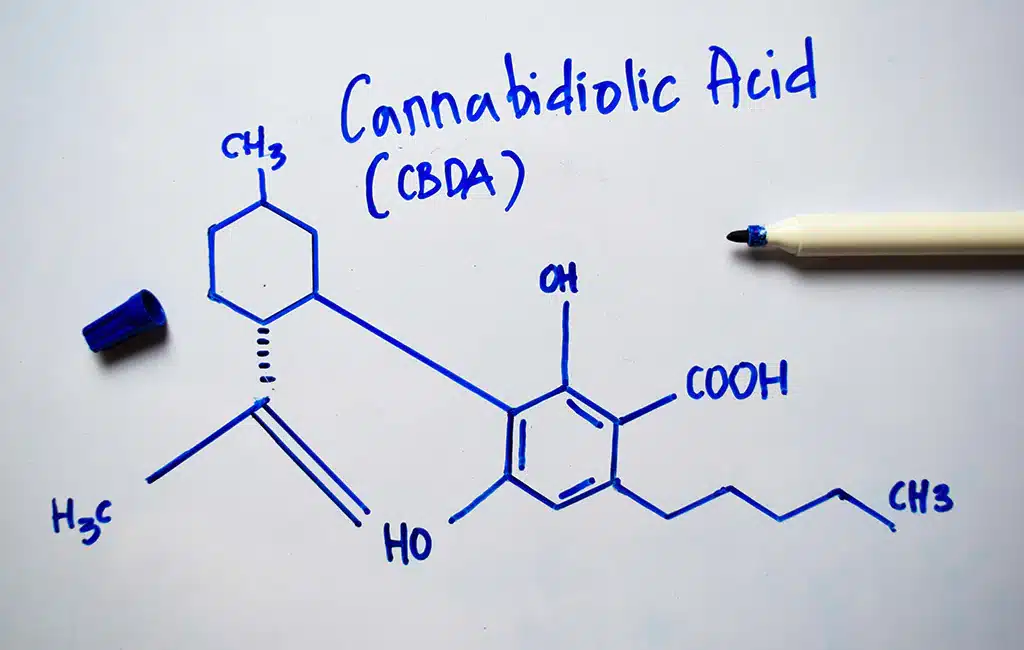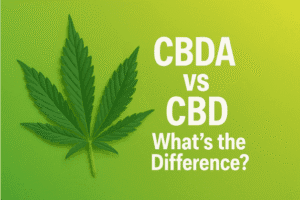You must have heard a lot about CBD. But now, there is CBDA, which is a different compound that people generally confuse CBD with. What is CBDA? What are CBDA benefits? What does CBDA do? Does CBDA make you high? Which is the best CBDA product out there? You need to remember that CBDA is not the same as CBD. They are different even though they have a close relationship. Here we will be talking about CBDA, benefits of CBDA, side effects and more of this powerful cannabinoid.
Sections
ToggleWhat is CBDA?
CBDA or cannabidiolic acid is the non psychoactive cannabinoid available in cannabis plants and is the acidic precursor to CBD. When the cannabis plant matures, CBDA is exposed to heat and the acidic molecule splits, thus leaving CBD behind. And this process is called decarboxylation and so, as CBDA ages and matures, it transforms naturally into CBD.
CBDA vs. CBD: What’s the Difference?
- CBDA is the acidic and most abundant cannabinoid, directly giving rise to CBD. The oral CBDA form has 3 times better absorption and 1000 times more potency at serotonin receptors.
- CBDA works differently than CBD, affecting the endocannabinoid pathway in an indirect way. Most of the cannabinoids connect to CB1 and CB2 receptors directly. But CBDA binds to the COX-2 (cyclooxygenase-2) enzymes.
- While CBD is easier to metabolize by the body, CBDA and CBD can work closely to enhance one another’s effects. Even though they are chemically different from each other, they have a lot of similar health benefits.
How CBDA Works in the Body

CBDA works on various targets in the body, mainly the TRP receptors. It increases the TRPA1 and TRPV1, reduces TRPM8, the changes which result in overall pain reduction.
Unlike CBD which has binding properties to CB1 and CB2, CBDA is there with low affinity to receptors. Rather, it has crucial off target effects like inhibiting COX-2 that in turn delivers therapeutic effects.
CBDA works best when combined with other terpenes and cannabinoids. This action is called the entourage effect. CBDA can thus enhance the potential of CBD and vice versa. CBDA may further make terpenes such as pinene and limonene more powerful.
Potential Benefits of CBDA
1. Inflammation relief
CBDA has anti-inflammatory properties and this helps to beat inflammation as well as help in pain management linked with swelling and inflammation. CBDA produces anti-inflammatory effects through its role as COX-2 enzyme inhibitor. COX 2 has anti inflammatory effects just like non steroidal anti inflammatory drugs inhibit such as aspirin.
2. Nausea reduction
CBDA works on serotonin receptors, thus making it useful for reducing and controlling nausea to a great extent. People having cancer may face nausea and this is mainly due to chemotherapy side effects. CBDA products like gummies and oil help reduce nausea.
3. Anxiety and stress management
Studies suggest that CBDA may help manage anxiety and stress through its interaction with the serotonin receptors. CBDA supports chronic pain and anxiety by targeting the serotonin receptors that regulate your mood, stress and expression of fear.
4. Cancer research
CBDA has also been found to have anti tumor benefits with the capability to shrink benign and cancerous tumors and also inhibit growth of breast cancer cells.
5. Pain reduction
One of the main areas which have most research is using CBDA for pain relief, especially inflammatory pains. With its anti-inflammatory effects, CBDA has the potential for reducing pain and swelling in the body.
6. Seizure control
With its neuro-protective effects, CBDA offers seizure control benefits apart from other therapeutic effects like Parkinson’s and Alzheimer’s disease.
Possible Side Effects and Safety of CBDA
There are many side effects linked with CBDA. Most of these effects are generally mild as this cannabinoid is not too active in the body as compared to CBD. Some of the possible effects include dry mouth, low blood pressure, mood changes, drowsiness and light-headedness.
These effects are more likely to be faced when you take heavy dosage or use the products frequently.
Talking about the safety of CBDA, it is better to consult a doctor before you start taking any CBDA products. Also, look for the products that have “raw CBD oil” written on it. This means that decarboxylation has not occurred and that the product has CBDA, not CBD.
Does CBDA Make You High?
Just like CBD, CBDA does not make you feel “high”. While little research is available on its effectiveness on humans, none of these suggest that one can feel disoriented or may have extreme psychoactive effects. Even though it has psychoactive effects like anxiety reduction, still it is non impairing. CBDA further interacts with the endocannabinoid system through inhibiting COX-2 enzyme that does not affect the central nervous system in a direct way.
How to Use CBDA?
Look for products with the words “raw CBD oil.” This labeling indicates that decarboxylation has not occurred, meaning that the product includes CBDA rather than CBD. Other good sources of CBDA include tinctures, creams, and gels.
To fight localized inflammation from a muscle sprain or other minor injury, apply a drop or two of CBDA oil to the affected area. If you’re experiencing nausea, a dab of CBDA tincture placed directly under the tongue could offer relief.
Conclusion
Taking CBDA essentially means you’re taking a better-absorbed form of CBD, and you’ll probably get more out of it than with the same amount of CBD alone. Since CBDA is dominant in hemp food, products, and seed oil, knowing this information is important for everyday consumers.
CBDA is superior in many ways when compared to CBD. A study published in the 24th Annual Symposium of the International Cannabinoid Research Society found CBDA is 19x more bioavailable than CBD. This makes it a more powerful therapeutic for a variety of instances and allows for lower doses to experience the therapeutic benefits. Additionally, research has found CBDA has a greater binding affinity to a variety of receptors. When using CBD and CBDA, one is able to feel greater effects from CBDA.




